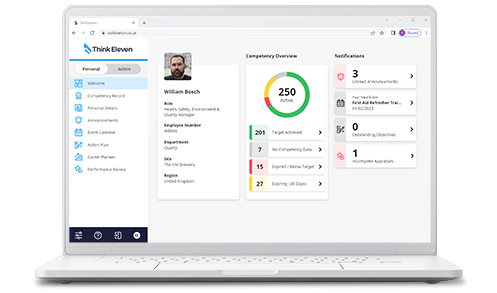In the realm of learning and development, efficiency is paramount. This comprehensive guide delves into the transformation from cumbersome and inefficient spreadsheets, to the strategic adoption of a Training Management System (TMS). Explore the limitations of spreadsheets, the benefits of a TMS, and crucial factors to consider when selecting the right system—a pivotal step in shaping a future where training is a strategic advantage, not just a necessity.
Mastering Workforce Efficiency
In the admin laden landscape of workforce training and development, the right tools can make all the difference. As organisations strive to enhance employee skills to keep pace in a competitive market, the onus of conducting learning and development (L&D) in a focused and cost-effective way typically falls upon the shoulders of L&D / HR departments.Traditionally the go-to method for training management was spreadsheets and filing cabinets full of certificates, but in today’s fast paced and highly regulated industries, slow, cumbersome and inaccurate spreadsheets simply are not effective enough.
There is a solution; A dedicated training management system (TMS) - an essential tool for many successful organisations to make the process of training management faster and easier. In this comprehensive guide, we will compare the functionality of a TMS to spreadsheets and highlight the key features to look for when sourcing a TMS.
Unlocking Success: Skills, System and Synergy
Employees equipped with the right skills and competencies is a linchpin to unlocking the full capability, capacity and ultimately, the success of an organisation. Visibility and understanding of the composition of workforce training is an essential component to ensure employees have the right training and skills they need to be competent, compliant and thrive in their role. Traditionally, organisations have relied on a process of manual data entry into spreadsheets for training management, leveraging the familiarity and simplicity they offer.
Spreadsheets have been the go-to solution for various organisational tasks, including training schedules, participant tracking, and basic performance analytics. Their ease of use and accessibility have made them a staple in small to mid-sized businesses aiming to manage training on a budget.
As an organisation grows and evolves, so does the regulatory, compliance and quality requirements to win new business and keep pace with the competition. The knock-on effect is the demand for focused and efficient training programs. This is where a Training Management System (TMS) comes into play, offering a comprehensive and streamlined approach to training administration, delivery, and tracking.
The Limitations of Spreadsheets
While spreadsheets have long been a crutch for many businesses, especially when it comes to training management, it's essential to acknowledge their limitations. The simplicity that once made them appealing can become a double-edged sword as organisations grow and training needs become more complex.
Data Accuracy Challenges:
Spreadsheets are prone to errors, whether it's due to manual data entry or formula mishaps. A simple typo can cascade into significant inaccuracies. This susceptibility to human error can hinder the reliability and validity of your training data.
Version Control Nightmares:
Managing multiple versions of a spreadsheet, especially when collaborated on by different team members, can quickly become a logistical headache. This version control challenge often leads to confusion and miscommunication within the training management process.
Scalability Issues:
As your organisation expands, so does the complexity of your training programs. Spreadsheets, designed for simplicity, will struggle with an increased volume and complexity of data, leading to a lack of scalability. This limitation becomes increasingly evident when managing large teams and the related diverse training requirements.
Security Concerns:
Spreadsheets often lack robust security features, making them susceptible to unauthorised access or accidental data breaches. In the era of heightened data privacy concerns, relying solely on spreadsheets for managing sensitive training information may pose a risk to your organisation's compliance standards.
Reporting and Analytics Limitations:
Extracting meaningful insights from spreadsheet data requires manual effort, making comprehensive reporting and analytics a time-consuming process. This limitation can hinder the ability to make data-driven decisions promptly.
Training Management Systems (TMS): Beyond the Constraints of a Spreadsheet.
A training management system allows an organisation to comprehensively address the shortcomings of using spreadsheets, whilst elevating training management activities to a new level of efficiency and effectiveness. Here are a few examples of how a TMS achieves this:
Automation of Tasks:
One of the key advantages of a training management system is in its automation capabilities. Mundane, time-consuming tasks that were once manual processes in spreadsheets are now automated with precision. From scheduling training sessions to automatic email notifications for expired or expiring skills that require retraining, a TMS takes the burden off administrative teams, allowing them to focus on more strategic tasks.
Centralised Data Storage and Accessibility:
TMS provides a centralised repository for all training-related data. This not only ensures data accuracy but also streamlines accessibility for authorised users. No more version control nightmares or data scattered across disparate spreadsheets a training management system consolidates information in one secure location, fostering collaboration and reducing the risk of errors.
Advanced Analytics for Informed Decision-Making:
A good TMS will be equipped with analytics and reporting tools that transform raw data into actionable insights. Training managers can track performance metrics, identify trends, and measure the impact of training initiatives more effectively. This data-driven approach empowers organisations to make informed decisions, optimising their training programs for maximum effectiveness.
Scalability to Accommodate Growth:
As organisations expand, a TMS can effortlessly scale to accommodate increased data volume and complexity. Whether you're onboarding new employees, launching additional training modules, or expanding into new markets. Training management systems provide the flexibility and scalability needed to support your evolving training needs.
Data Security:
With features like user access controls and encryption, organisations can trust that their data is protected from unauthorised access, ensuring compliance with privacy regulations, and bolstering overall data integrity.
Selecting the Right Training Management System: A Critical Decision for Success
Choosing the right TMS for your organisation is not just a preference—it's a strategic decision that directly impacts the success of your training initiatives. In the upcoming sections, we will guide you through the factors to consider when selecting a TMS, ensuring you make an informed choice aligned with your organisation’s requirements and objectives.
Training Management System: Factors to Consider
Selecting the right TMS should align seamlessly with your organisation's unique needs, size, industry, and regulatory requirements.
Budget Constraints:
Assess the initial investment and weigh it against the long-term efficiency gains. Look for a TMS that offers a transparent pricing structure and aligns with your budgetary considerations.
Organisational Size:
Consider the scalability of the TMS. Whether you are a small startup or an enterprise, ensure the TMS can adapt to your organisation's size and growth trajectory.
Industry and Regulatory Compliance:
Investigate if the TMS complies with industry-specific regulations. Look for features that facilitate adherence to compliance standards, ensuring your training programs meet regulatory requirements.
Training Program Complexity:
Evaluate the TMS's capability to manage the complexity of your training programs. Choose a system that offers the necessary features for your specific training needs, whether they involve certifications, onboarding, or ongoing skill development.
User-Friendliness:
A system that is intuitive and requires minimal training promotes user adoption and reduces the learning curve for your team.
Integration Capabilities:
Review the integration capabilities with other tools used within your organisation. A TMS that seamlessly integrates with your existing ecosystem fosters a more connected and streamlined workflow.
Data Security and Compliance:
Look for a system or provider that adheres high data security and compliance standards to safeguard sensitive training information.
Training Analytics & Reporting:
Assess the TMS's analytics and reporting capabilities. Look for tools that provide comprehensive insights, empowering you to make data-driven decisions and continually optimize your training programs.
By meticulously considering these factors, you can make an informed decision tailored to your organisation's unique requirements. Remember, the right TMS is a powerful tool that strategically enhances your training management capabilities for sustained success.
Conclusion
As we've explored the features, considerations, and nuances, it's evident that choosing the right training management system is not just about picking a tool; it's about selecting a strategic partner in your journey towards delivering a more efficient and impactful workforce.
Considering the factors previously discussed — budget, organisational size, industry requirements, and long-term goals, we’ve established that a TMS provides a meaningful step forward from relying on spreadsheets. Moreover, the right system can be a catalyst for positive transformative change, enhancing collaboration, reliable and compliant data, and invaluable workforce insights.
Next Steps…
Are you interested in embarking on journey to an optimised training, skills and competency management? Share your thoughts with us on this guide, ask questions, or explore additional resources on our website. Your organisation's success awaits, and we're here to support every step of the way. Together, let's shape a future where training is not just a necessity but a strategic advantage.


